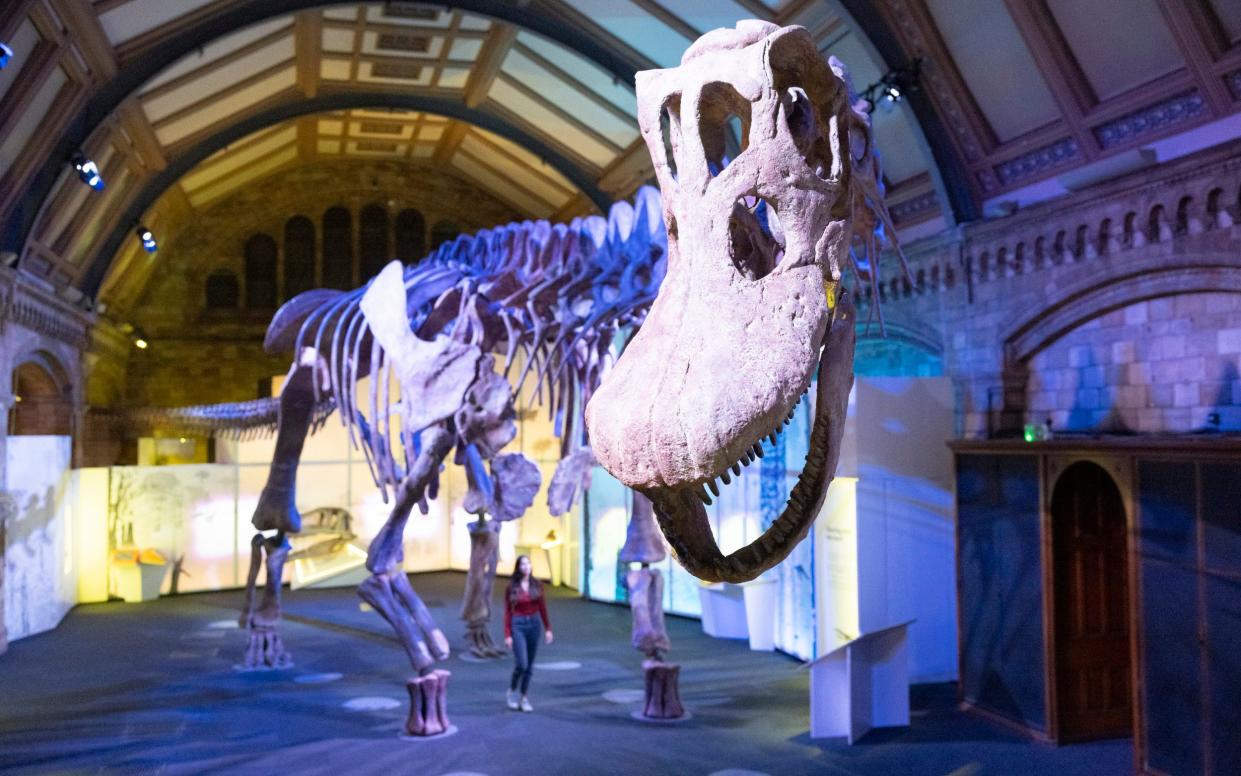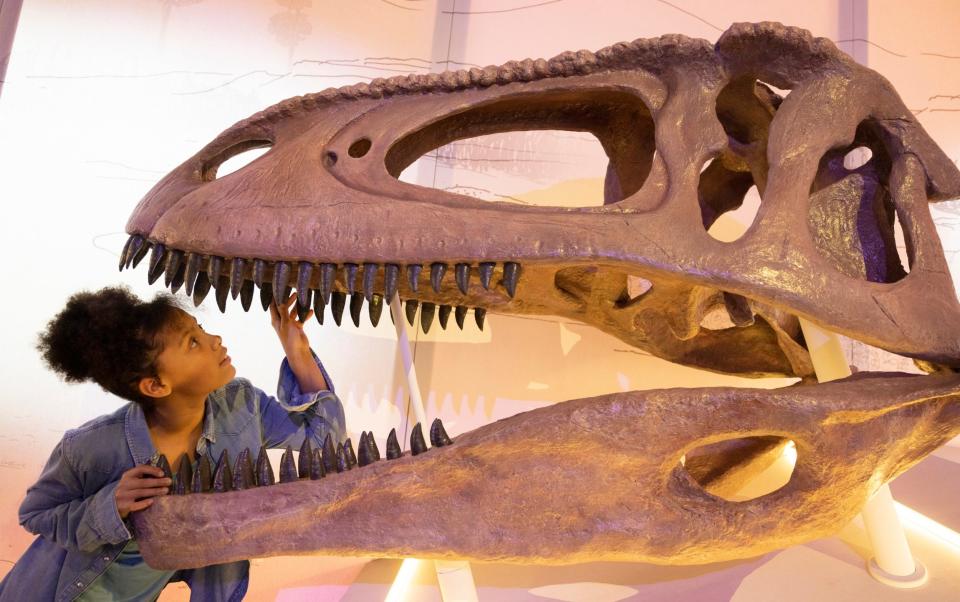100 million years old, 37 metres long... say hello to London’s newest resident

You can understand the reaction, because who hasn’t experienced a friend or family member turning up with an unwieldy new purchase that elicits an instant, incredulous response of “And where on earth do you think we’re going to put that?”
But when staff at the Natural History Museum realised the scale of their latest exhibit, even the experts who knew its measurements to the nanometre had to pause and double check. They knew where they were going to put it – in the vast Waterhouse Gallery – but it would definitely fit... wouldn’t it?
“It barely fits. It does fit, it does, I’m very glad to say, but it really does dominate the space in a way that nothing else could,” says Professor Paul Barrett, a dinosaur specialist and head of fossil vertebrates at the museum.
The newcomer is the “titanosaur”: a replica skeleton of Patagotitan mayorum, one of the largest creatures ever to walk on land, which heaved its way across the plains of Patagonia roughly 100 million years ago. The real thing was discovered in 2010 by an Argentinian farmer who spotted a bit of thigh bone, dug a little, realised it was a bit bigger than a cow’s, then called in the local paleontologists from Museo Egidio Feruglio. It turned out to be 8ft, the longest thigh bone ever found, and took them three weeks to exhume (a cow’s, for reference, is around 18in).
Pure numbers do little justice to the Patagotitan; it’s best to throw some in comparisons for good measure. At 37m long, it’s the same length as an Airbus A320, or the Statue of Liberty if she fell over. At 17m tall, it would require Tower Bridge to be raised if it fancied a swim down the Thames. Ten times as big as the biggest elephant, its heart was the same size as a Spacehopper, and pumped the equivalent of a barrel of beer with each beat. Every day, this herbivore consumed more than 129kg of plants, which is about the same as 215 cauliflowers. But it would take 10 days for its capacious stomach to digest anything. Best not to think about the methane output.
If you’ve seen Hope, the Natural History Museum’s iconic blue whale skeleton, you’ve seen a massive animal. If you’ve seen Dippy, the museum’s beloved diplodocus skeleton cast, you’ve seen a massive dinosaur. Patagotitan – which really deserves a similarly cute name, like Peter – is significantly bigger than both. All of which is to say: getting it in wasn’t easy.
“An exhibition like this usually takes about two years of planning from start to finish, but thanks to Covid, this one’s been even longer,” says Sinéad Marron, the museum’s exhibition and interpretation manager.
“As a team, we’re pretty nifty at putting up and taking down dinosaurs, especially because Dippy’s just done a national tour, but the scale of this one is different. Particularly some of the real fossils. The thighbone is 500kg. That comes with its own challenges…”
The cast, along with various real fossils also going on display from Friday, arrived at the museum three months ago in 36 crates, having been flown from Argentina (it’s borrowed from Museo Egidio Feruglio) and then driven carefully down the M4 from Heathrow.
At that point, Marron says, it was a case of assembling the 225 bone casts “like the world’s biggest jigsaw puzzle”. That took 18 people a fortnight, with two alternating project managers and various extra bodies to watch and learn for a probable forthcoming tour.
To ensure a comfortable fit in the exhibition space, as well as teasing its reveal, the tail has been curled around a pillar near the entrance. Visitors can see this, but the rest of the skeleton is shrouded until a big reveal later on. It’s an effective technique, and gives a glimpse of what it must have been like to be a diminutive, scurrying little dinosaur just trying to not get squashed in the Cretaceous period. Whatever that belongs to, you think as you look up, must be absolutely gargantuan.
“There were other considerations with it as well,” Prof Barrett says. “The cast weighs a couple of tons, so even positioning it in relation to the support piles in the floor was important. It was complex, logistically, to make sure it fitted, and that it fitted aesthetically. But also just that it didn’t fall through the floor.”
He’s still taken aback by the sheer size of the thing. “I’ve seen an awful lot of dinosaurs in my time, and the scale is still unbelievable. It makes Dippy look like a very small little brother.”
Prof Barrett had seen some fossils before, having visited Patagonia, where the bones were discovered with those of six other Patagotitans nearby. Nobody knows why they all died together, or indeed why the species went extinct altogether, or even why Patagonia is so rich an area for fossil hunting.
The discovery made global headlines, and inspired a 2016 Sir David Attenborough documentary, as experts wondered whether it might be the biggest animal to ever live. It’s a tricky claim to stand up, given there were other, similar-sized titanosaurs around, and that blue whales may be shorter but are definitely heavier, but nor can it be entirely refuted.
The exhibition runs until January 2024, and should keep the thousands of visitors – many of them young – engaged far beyond the moment they go face to face with the Patagotitan’s toothy grin. As well as play games, they can touch a model replica of a 69-million-year-old grapefruit-sized egg, learn all about life in the Cretaceous Period, and even stand on a set of scales that will tell them how old a titanosaur is when it’s the same weight as them. (Not to brag, but it’s just six weeks for me.)
At a preview this week, adult visitors were as giddy as the kids, who are all encouraged to touch the cast as much as they like (regrettably, no riding or climbing, though). Aged 31 and a half, I lost almost 20 minutes playing a game helping baby Patagotitans across a river, and that was before I greeted the skeleton itself, and came to the realisation that its rib cage is about the size of my flat. Humbling; I think I should upsize.

After more than two years of planning and installation, and 12 years since the discovery – time in which he’s had to watch the titanosaur visit museums in Argentina, Chicago and New York before London – Prof Barrett is just desperate to let visitors in. It should, he hopes, allow them to understand the importance of the giant, threatened creatures that lope across our planet today, such as the African elephant. And children’s fascination with dinosaurs shows no sign of abating.
“There’s simply nothing that lives on land today that resembles a dinosaur in scale, except for whales, and people don’t see whales every day. Dinosaurs also have a certain cache, thanks to Hollywood. They have quite bizarre shapes, sizes, behaviours, which we don’t see in living animals. But we know they were living animals. So they’re monsters that were real. It’s a trade-off between mythological beast and reality,” he says.
It irks him that the old media whore Tyrannosaurus Rex hogs the headlines. “Yes, it’s very frustrating, when there are hundreds of other species out there. The T-Rex is a spectacular dinosaur, but equally there are plenty of others desperate for the same attention.”
Like, for instance, the Patagotitan, against which the rest can measure up now. After that, who knows what’ll be dug up next?
“It’s one of the great things about working on dinosaurs,” Prof Barrett says, “you just don’t know what’s out there, there might be something even bigger.”
Bigger? The installation team might need a lie down before that.
Titanosaur: Life as the biggest dinosaur is open at the Natural History Museum until Jan 7 2024, with adult tickets from £16

 Yahoo News
Yahoo News 
